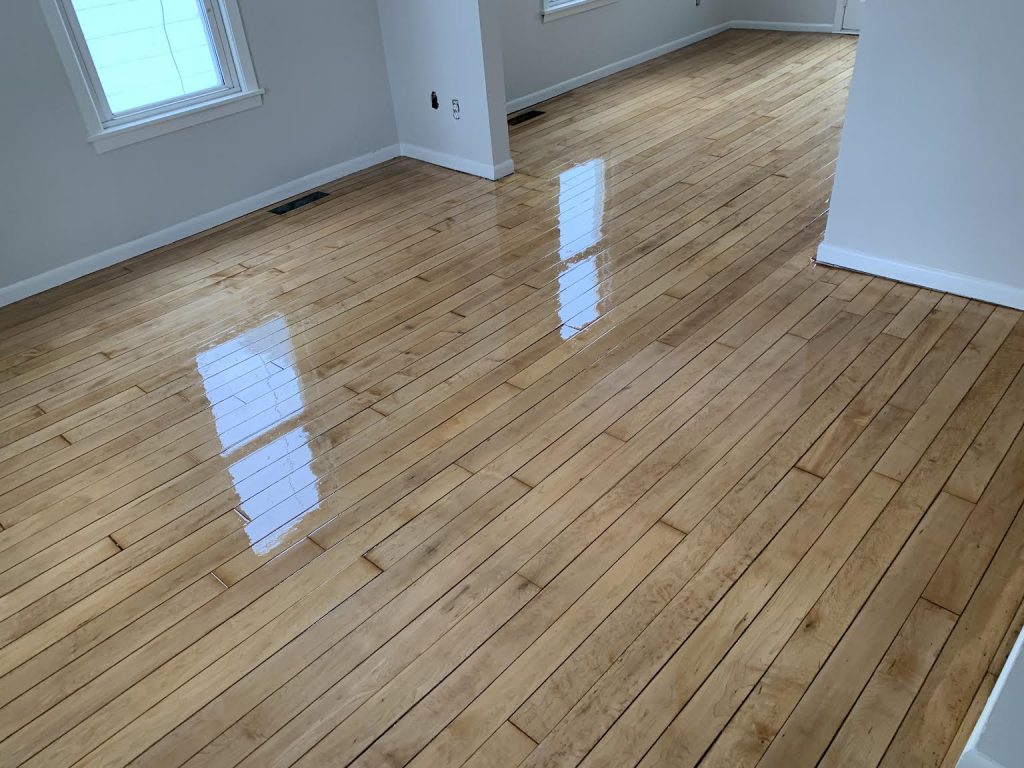Gaps In Wood Floors

Gaps Between Floor Boards: What Can You Do About Them?
Gaps Between Hardwood Floorboards: Causes, Fixes, and Hardwood Floor Refinishing
Hardwood floors are a timeless feature in many homes, offering natural beauty, durability, and a sense of warmth. However, over time, homeowners often face an issue that can detract from the aesthetic and integrity of their hardwood floors: gaps between the floorboards. These gaps can range from tiny cracks to larger, more noticeable spaces, and they may appear unexpectedly. While some gaps are a normal part of the aging process of hardwood floors, others can signal potential issues. Understanding the causes of these gaps and how to fix them is essential for maintaining the beauty and functionality of your hardwood floors.
At Choice Hardwoods, a top-rated flooring contractor in the Twin Cities area, we understand the intricacies of hardwood flooring. Whether you’re dealing with minor gaps or large, unsightly cracks, we’re here to guide you through the process of fixing gaps in hardwood floors, along with the best practices for refinishing and maintaining your floors.
What Causes Gaps Between Hardwood Floorboards?
Before diving into solutions, it’s essential to understand the root causes of gaps between hardwood floorboards. In many cases, gaps are a natural occurrence, especially in areas with significant fluctuations in temperature and humidity. However, there are also other factors that can contribute to the widening of these gaps.
1. Changes in Humidity and Temperature
One of the most common causes of gaps between hardwood floorboards is fluctuations in humidity and temperature. Hardwood is a natural material, and like all wood products, it expands and contracts in response to environmental changes. In the winter months, when the air is dry and heating systems are running, the wood tends to shrink, creating small gaps between boards. During the warmer and more humid summer months, the wood absorbs moisture from the air and expands, causing the gaps to close up again.
This seasonal expansion and contraction are typically temporary, and the gaps will often tighten back up as the humidity and temperature stabilize. However, if the gaps are significant or persistent, they may require more than just waiting for the weather to change.
2. Improper Installation or Acclimation
Another cause of gaps between floorboards can be improper installation or lack of acclimation. Before installation, hardwood floors should be allowed to acclimate to the temperature and humidity of the environment where they will be installed. If this step is skipped or rushed, the wood may shrink or expand after installation, leading to gaps between the boards.
Additionally, if the flooring contractor does not leave enough room for the natural expansion and contraction of the wood, it can lead to unsightly gaps. Hardwood floors need to have proper spacing at the edges of the room to allow for movement without causing damage.
3. Aging and Wear of the Floor
As hardwood floors age, they can naturally develop gaps due to wear and tear. Over time, the boards may lose moisture content, and the nails or staples securing the boards to the subfloor may loosen. This can cause the boards to shift and create noticeable gaps. While this is a natural part of the aging process, it can be unsightly and may require intervention to restore the floor’s integrity.
4. Subfloor Issues
In some cases, gaps in hardwood floors can be caused by problems with the subfloor. If the subfloor is uneven, improperly installed, or has shifted over time, it can lead to gaps between the floorboards. This is more common in older homes where the subfloor may have settled or shifted.
5. Water Damage or Spills
Another cause of gaps is water damage. If water is spilled on the floor or if there’s consistent exposure to moisture, the wood can swell and warp. Once the moisture is gone, the wood may shrink, leaving behind gaps. Over time, this process can cause permanent damage to the wood, resulting in larger gaps that do not close up on their own.
Fixing Gaps in Hardwood Floors
While some gaps in hardwood floors are natural and temporary, larger or persistent gaps may require more involved solutions. In cases where the gaps are too wide to close up naturally, there are a few steps you can take to repair them.
1. Allow the Floor to Adjust to Seasonal Changes
If the gaps are small and you notice that they tend to close up during the more humid months, it may be a sign that they are simply a result of seasonal changes. In this case, no immediate action may be required. You can monitor the floor over the course of a year to see if the gaps expand and contract with the seasons.
If the floor does not return to its original condition, or if the gaps are large, then more extensive repairs may be necessary.
2. Wood Filler and Filling the Gaps
If you have gaps between the floorboards, one of the most common methods for fixing them is by using wood filler. This process involves filling the gaps with a material that closely matches the color and texture of the wood. However, it’s essential to note that this method is typically a temporary solution for small gaps, and may not be suitable for larger or more persistent gaps.
The process of filling the gaps with wood filler involves carefully applying the filler to the gaps, ensuring that the entire crack is sealed. The filler should be pressed into the gap and smoothed to avoid any lumps or visible seams. Once the filler has dried, the floor should be sanded down to ensure an even surface.
It’s important to note that wood filler may not be the best solution for large gaps. If the gaps are too wide, the filler may not hold up over time, leading to further issues.
3. Trowel Filling and Full Hardwood Floor Refinishing
For floors with significant gaps that don’t respond to minor repairs, a more invasive solution is required. In these cases, hardwood floor refinishing is often the best option.
To fix large gaps in hardwood floors, a flooring contractor may choose to use a method called trowel filling. This process involves applying a thicker wood filler to the floor using a trowel. The filler is spread over the floor until all the gaps are filled. Once the filler is applied, it is allowed to dry and harden before the floor is sanded down to create an even surface.
Once the filler has been applied and dried, the floor will need to undergo full sanding and refinishing. The sanding process involves using heavy-duty sanding equipment to remove the top layer of the floor, along with the filler and any imperfections. This ensures that the floor is level and smooth, and that the filler blends seamlessly with the surrounding wood.
After sanding, the floor will be refinished with a new coat of stain and finish to restore its appearance. The refinishing process protects the wood, enhances its color, and helps ensure that the floor remains durable for years to come. A hardwood floor refinish is necessary to make sure the new filler blends with the rest of the floor and that the entire surface looks cohesive and polished.
At Choice Hardwoods, we pride ourselves on offering high-quality hardwood floor refinishing services. As a top-rated flooring contractor in the Twin Cities area, we understand the importance of addressing gaps in your hardwood floors properly. Our team has the expertise to handle everything from minor repairs to more extensive refinishing projects, ensuring that your floors look and feel as good as new.
The Hardwood Floor Refinishing Process
The hardwood floor refinishing process is critical to ensuring that your floor looks its best after filling the gaps. Here’s what it generally looks like:
- Preparation: First, the floor is cleared of any furniture or obstacles. If necessary, the gaps are filled with a wood filler that matches the floor’s color.
- Sanding: Using industrial-grade sanders, the top layer of the hardwood floor is removed. This step smooths out any filler and evens out the surface.
- Cleaning: After sanding, the floor is thoroughly cleaned to remove any dust or debris.
- Staining: Once the floor is clean and smooth, the desired stain is applied. The stain gives the floor a new color and enhances its natural beauty.
- Sealing: Finally, a protective finish is applied to the floor. This finish can be a polyurethane or other sealant, and it provides a layer of protection against moisture, dirt, and wear.
Conclusion
Gaps between hardwood floorboards are a common issue for homeowners, but with the right approach, they can be repaired and your floor can be restored to its former beauty. Whether the gaps are caused by seasonal changes, improper installation, or the natural aging of the floor, there are several ways to address the issue, ranging from temporary fixes like wood filler to more extensive repairs such as hardwood floor refinishing.
If your hardwood floors are suffering from significant gaps or have become unsightly over time, a full refinishing with trowel filling and hardwood floor sanding is often the best solution. At Choice Hardwoods, our expert team of flooring contractors in the Twin Cities can handle any hardwood floor repair or refinishing project, ensuring your floors remain beautiful and functional for years to come. Whether you’re dealing with minor gaps or need a full hardwood floor refinish, we’re here to help you restore your hardwood floors to their original beauty.

